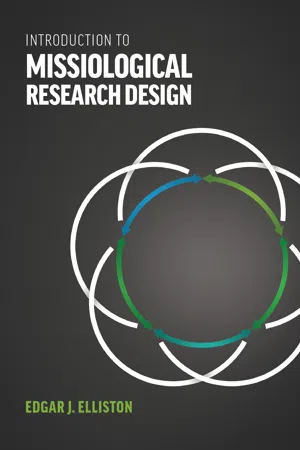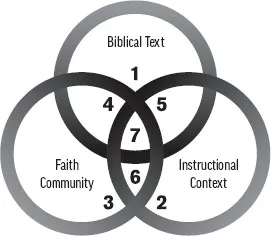![]()
1
MISSIOLOGY AS A RESEARCH DISCIPLINE
This chapter describes “missiology” as a research discipline by showing the constituent parts of an academic discipline and how they are being addressed in missiology.
Missiology clearly stands as an academic discipline in its own right. Missiology as an academic discipline both has an “organized body of knowledge” and organized methods of “accumulating and ordering that knowledge” (Dressel and Marcus, 1982). While others have addressed this issue in missiological discussions,3 this chapter primarily addresses missiology as a research discipline, which serves as a base for designing research. As an academic discipline missiology does not have a unique or distinctive methodology. However, it does embrace components common to other academic disciplines around a theological core. The methods used to support the Church in mission are as wide as ethical, valid, and reliable methods permit in other academic disciplines. Any discipline that addresses human behavior may serve missiology for the purpose of providing relevant and valid information and contributing to the growing body of missiological theory. While theological research differs from social science research as it addresses issues of trustworthiness and truth on the bases of sound hermeneutical and exegetical bases, theological research serves a critical and constant role in missiological research. The methods used to research missiological topics often require multidisciplinary perspectives because of the complexities of the subject matter. When the topics cross ecclesial, religious, cultural, spiritual, time, geographical, economic, political and other boundaries, multiple disciplines are required.
The author has an acquaintance who lives in a hilly, wooded area near St. Joseph, Missouri. He built his house in an octagonal shape with windows facing eight directions. Every view outside differs and to know what is in the house one would have to look in from each of the windows. Each window provides a different perspective to the interior of the house, but no single window provides a full view. However, every view is complementary and consistent with the other views. In a similar way, different disciplines allow one to peek into the complex realities of the missio Dei. When conducting research with rigorously reliable and valid methods, each discipline will provide a complementary and consistent view. As the author’s friend’s family may change the furniture or add new furniture, thus changing the interior design in their house, human situations are always dynamic. One may need new combinations of views to explain both what is happening and what to do about it. Human contexts are always dynamic and often require fresh combinations of methods both to explain what is occurring and to provide a base for missional action in that context. Differences in worldview lead to differences in exegetical and hermeneutical methods undergirding theological perspectives which aim at trustworthiness and truth.
Dressel and Marcus in their book, On Teaching and Learning in College (1982), present a useful description of the components of a disciplinary structure. Their perspective, while not specifically targeting missiology, presents the range of issues that one would expect to find in an academic discipline. The following sections are based in part on their outline.
Conceptual Components
A range of conceptual issues serve to provide the substance of missiology. These issues all fall within the broad concerns of the mission of God, or as they are referred to in this text, the missio Dei. Van Engen in his helpful chapter, “What is Mission Theology” (1996, pp. 11-36), presents missiology as an academic discipline from a mission theology perspective. In this chapter he points to five key component parts of missiology which require multidisciplinary research with a theological core:
• missio Dei (the mission of God),
• missio hominum (the mission of humans),
• missiones eccesiarum (the mission of the church),
• missio politica oecumenica (mission as it draws from and impacts global human civilization),
• missio futurum (mission as it relates to the “predictable issues of God’s mission as they work out in human history, and,
• missio adventus (“the in-breaking (the advent) of God, of Jesus Christ in the Incarnation, of the Holy Spirit at Pentecost, of the Holy Spirit in and through the Church” (pp. 29-32).
Others have written from different disciplinary perspectives including: Tippett (1973) of Fuller Theological Seminary and Whiteman (1987) of Asbury Theological Seminary from a social science perspective, Forman (1987) of Yale University from a history perspective, and Zahnheiser (1987) of Asbury Theological Seminary from a religions perspective. Van Rheenen (1996, 2006) formerly of Abilene Christian University has written a wide range of missiological books and articles.
Arenas of Interest
The central concern for missiology is the missio Dei, mission of God. As a subject area, it spans human history from the time of the creation of Adam and Eve because they were initial players in the mission of God. The main concern focuses on God’s desire to reconcile humankind to Himself. The revelation of this plan, the initiatives taken in this plan, the players in this plan, and the opponents to this plan all come within the scope of the concerns of missiological concern. Missiology, while primarily focused on God’s mission for humankind, ranges across three major arenas: the physical environment in which people live, their socio-cultural environment, and their spiritual environment. As each of these concerns relates to God’s central mission for humankind, it comes under the concerns of missiology.
In 1982 the author used a Venn diagram that served to explain some missiological research he was doing among the Samburu people in north central Kenya. From this diagram he raised seven questions about relationships and the integration of the standards of the biblical text with both the context and the mission community. This diagram illustrates the need for an integrated multidisciplinary approach to missiology.
Each of the numbers in Figure 2 relates to a question that needed to be addressed. The same kinds of issues arise in many kinds of missiological research.
FIGURE 2
Contextual Frame for Samburu Study
1. What is the biblical standard? What does the biblical text say?
2. What are the characteristics of the people and situation being served? In this case it was the Samburu people who were being studied.
3. What are the missionary/missional perspectives and values? What do they bring to the situation?
4. What is the relationship between the missionary values and perspectives and the biblical text? One must evaluate personal and cultural perspectives from the biblical text just as other culture’s views must be judged by the same standard.
5. What is the relationship between the values and perspectives of the people being served and the biblical values? An interesting finding in my study was that in terms of leadership values the traditional Samburu were in many ways closer to biblical values than the missionaries who were going to work with them.
6. What is the relationship between the values and perspectives of the missionaries and the people being served?
7. How should the values from the two human contexts be integrated under the biblical standard?
This simple diagram illustrates how at least theology, history, anthropology, sociology, political science, economics, comparative religion, geography, linguistics, and education can all provide useful disciplinary perspectives for investigating the complexities involved. Van Engen, writing in 1996, used essentially the same Venn diagram to illustrate the “Tripartite Nature of Theology of Mission” (1996, p. 21).
Key Assumptions of Missiological Research
Assumptions of people from other theological persuasions will differ from what is expressed in this section. However, some key assumptions that under gird evangelical missiology include the following: The mission to be studied is a divinely appointed mission. Human aspirations of power, colonialism, cultural imperialism, political aspirations, or economic conquest did not inspire this task. Human resources alone do not carry out this task, but rather it has an under girding spiritual power dimension that is always present. While it is concerned about human socio-cultural systems and structures, these systems and structures are not in themselves the primary focus, but serve as instruments to help or hinder the fulfillment of the missio Dei.
While a range of academic disciplines may serve to inform and provide methodological techniques to gather and interpret information about the missio Dei, these disciplinary approaches in and of themselves do not address God’s mission except for theology. Theology is the outworking of people’s thinking about how to interpret God’s revelation and His action among them as God is working to accomplish His mission. Theology and missiology are then inextricably linked with the missiologist considering theology to be a subset of missiology. And, the theologian often considers missiology as a subset of theology. Throughout the interplay of the social science and theological methods, concerns, and assumptions the researcher must continue to engage critical thinking at every juncture. The social science contributions must focus on valid and reliable data even as the theological concerns demand trustworthiness and truth.
Scope and Types of Missiological Research
In present-day missiology, missiological research may be typically divided into two broad related, but differing arenas: academic missiology and applied missiology. Academic missiology typically seeks to broaden the theoretical bases of missiological research. Various forms of historical and theological research typically come into focus in this kind of missiological research. Broad encyclopedic studies often form major goals of this kind of research. Some outstanding examples of this kind of research would include such diverse works as Barrett’s World Christian Encyclopedia (1982) and the annual updates to statistical estimates of the world Christian population published in the Bulletin of Missionary Research. Or Johnstone’s Operation World (2001), in which current reasonable descriptions are given of individual countries, their Christian populations, and prayer needs. Latourette’s monumental History of Christian Expansion (1937-1945) or Orr’s many works about the history of awakenings and revivals all serve this genre well. Bosch’s Transforming Mission: Paradigm Shifts in Theology of Mission (1991) serves this genre from a theological perspective. All of these works have required an enormous amount of research leading to the development of missiological theory.
On the other hand, applied missiology is another genre of missiological research that takes on a much more immediate and practical sense. One could cite many outstanding examples of applied missiology as well. Some researchers keep this kind of research in-house for specific applications. Linguistic research done by Wycliffe Bible Translators or developmental research done by World Vision fit well into this genre. Applied missiological research has focused on such diverse issues as church planting, curriculum improvement for leadership training, contextualizing theology, Bible translation, leadership emergence patterns, cross-cultural communication, business as mission, and power ministries.
Both academic and application-oriented research has contributed to the other arena. However, a given researcher may choose to focus on one, the other, or in some cases both. Each has an important role to play in missiology. Each broad approach has developed a set of risks. A risk that commonly accompanies academic missiology is its occasional overemphasis on the theory with little thought to the application or relevance of the theory to real-life missiological situations. A parallel risk from the more applied side of missiological research has often experienced a focus on immediate action without a firm rooting in what could have been learned from other precedent research (theory). For example, the author participated in a mission conference in which the pastor of a large congregation went to visit a south Asian country. He had never traveled there before. He did some observational “research.” He was present in the country for about two weeks. What he saw, experienced, reported, and recommended while all true to what he saw and believed, did not take into account what has been learned in any precedent research (missiological theory) or ethnographic studies. The recommendations from his “research” would likely lead to long-term dependencies and strained relations (based again on the recorded experience of others—theory). If, on the other hand, he had only read the mission history of the area, read books about church planting and integrated development...

